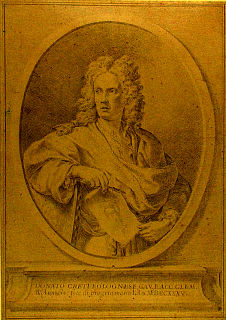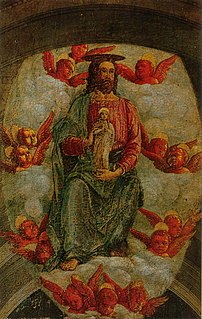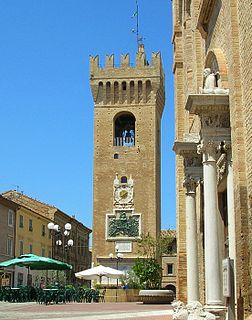
Lorenzo Lotto was an Italian painter, draughtsman and illustrator, traditionally placed in the Venetian school, though much of his career was spent in other North Italian cities. He painted mainly altarpieces, religious subjects and portraits. He was active during the High Renaissance and the first half of the Mannerist period, but his work maintained a generally similar High Renaissance style throughout his career, although his nervous and eccentric posings and distortions represented a transitional stage to the Florentine and Roman Mannerists.

Guido Reni was an Italian painter of the Baroque period, although his works showed a classical manner, similar to Simon Vouet, Nicholas Poussin and Philippe de Champaigne. He painted primarily religious works, but also mythological and allegorical subjects. Active in Rome, Naples, and his native Bologna, he became the dominant figure in the Bolognese School that emerged under the influence of the Carracci.

Francesco Albani or Albano was an Italian Baroque painter who was active in Bologna (1591–1600), Rome (1600–1609), Bologna (1609), Viterbo (1609–1610), Bologna (1610), Rome (1610–1617), Bologna (1618–1660), Mantova (1621–1622), Roma (1623–1625) and Florence (1633).

Giacomo Cavedone (1577–1660) was an Italian Baroque painter of the Bolognese School.
Dino Ferrari was an Italian painter. He was born and died in Ascoli Piceno.

Giuseppe Maria Crespi, nicknamed Lo Spagnuolo, was an Italian late Baroque painter of the Bolognese School. His eclectic output includes religious paintings and portraits, but he is now most famous for his genre paintings.

Donato Creti was an Italian painter of the Rococo period, active mostly in Bologna.

Vitale da Bologna, also known as Vitale di Aymo de' Cavalli or Vitale degli Equi, was an Italian painter of the Early Renaissance.

Segna di Bonaventura, also known as Segna de Bonaventura, and as Segna di Buonaventura, was an Italian painter of the Sienese School. He was active from about 1298 to 1331. In 1306 he painted a panel for the office of the Biccherna in the Palazzo Pubblico in Siena. In 1317 he painted an altar panel for the convent of Lecceto. In 1319 he repaired a figure of the Virgin in the Palazzo Pubblico. In 1321 he painted a panel for the Palazzo Pubblico. Segna di Bonaventura’s sons Niccolò di Segna and Francesco di Segna di Bonaventura were also painters of the Sienese School

The Pinacoteca Nazionale is a national museum in Siena, Tuscany, Italy. Inaugurated in 1932, it houses especially late medieval and Renaissance paintings from Italian artists. It is housed in the Brigidi and Buonsignori palaces in the city's center: the former, built in the 14th century, it is traditionally identified as the Pannocchieschi family's residence. The Palazzo Bichi-Buonsignori, although built in the 15th century, has a 19th-century neo-medieval façade based on the city's Palazzo Pubblico.

Simone di Filippo Benvenuti, known as Simone dei Crocifissi or Simone da Bologna, was an Italian painter. Born and dead in Bologna, he painted many religious panel paintings, and also frescoes in the churches of Santo Stefano and San Michele in Bosco, both at Bologna.
Vincenzo Milione (1735–1805) was an Italian painter.
Giovanni Battista Sangiorgi (1765–1837) was an Italian painter of the Neoclassical period
Pietro di Giovanni Lianori was an Italian painter, active in Bologna.

Giovanni di Ottonello was an Italian painter of the Gothic period.
Antonio Muzzi was an Italian figure and history painter, active in both Bologna and St Petersburg. He trained in the Academy of Fine Arts of Bologna, and became a docent at the academy. Muzzi was commissioned by the marchese Gioacchino Pepoli to paint La cacciata degli austriaci da Porta Galliera l’8 agosto 1848, which depicts a battle in which the marchese participated. The canvas is now displayed in the Museum of the Risorgimento of Bologna.

Christ Bearing the Soul of the Virgin is a tempera on panel painting measuring 27.5 by 17.5 cm by Andrea Mantegna. It was completed around 1462 and is now in the Pinacoteca Nazionale in Ferrara. It shows Christ in an almond-shaped cloud bearing the soul of the Virgin Mary straight to heaven after her death, accompanied by cherubs - the soul is represented by a statuette, rather than the more usual symbol of a child.

The Mystic Marriage of St Catherine is a c.1529 oil on panel painting of the mystical marriage of Saint Catherine by Parmigianino, now in the National Gallery, London, who acquired it in 1974. It was engraved by Giulio Bonasone.

Last Supper is a 1568 painting by El Greco, now in the Pinacoteca Nazionale di Bologna.


















